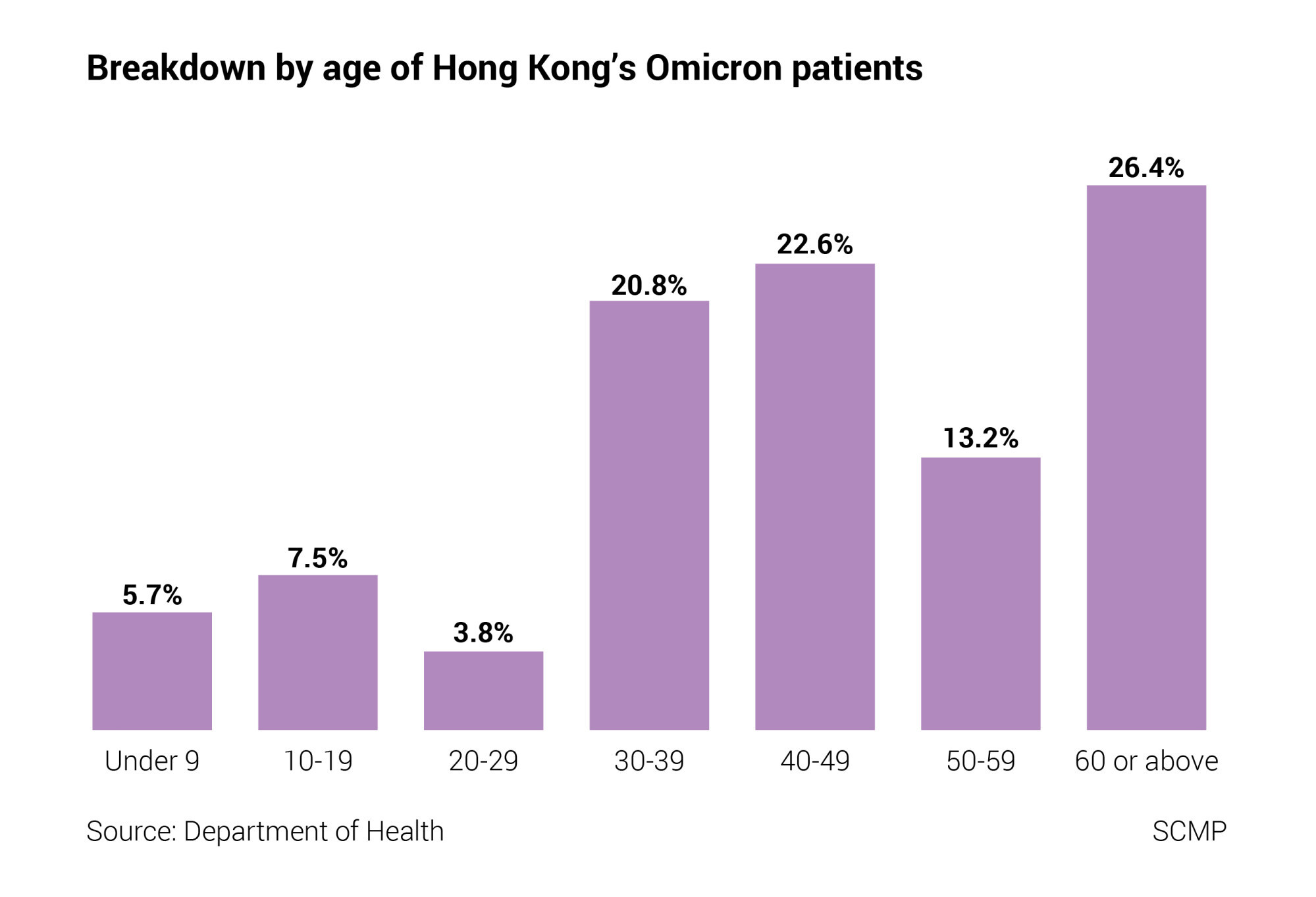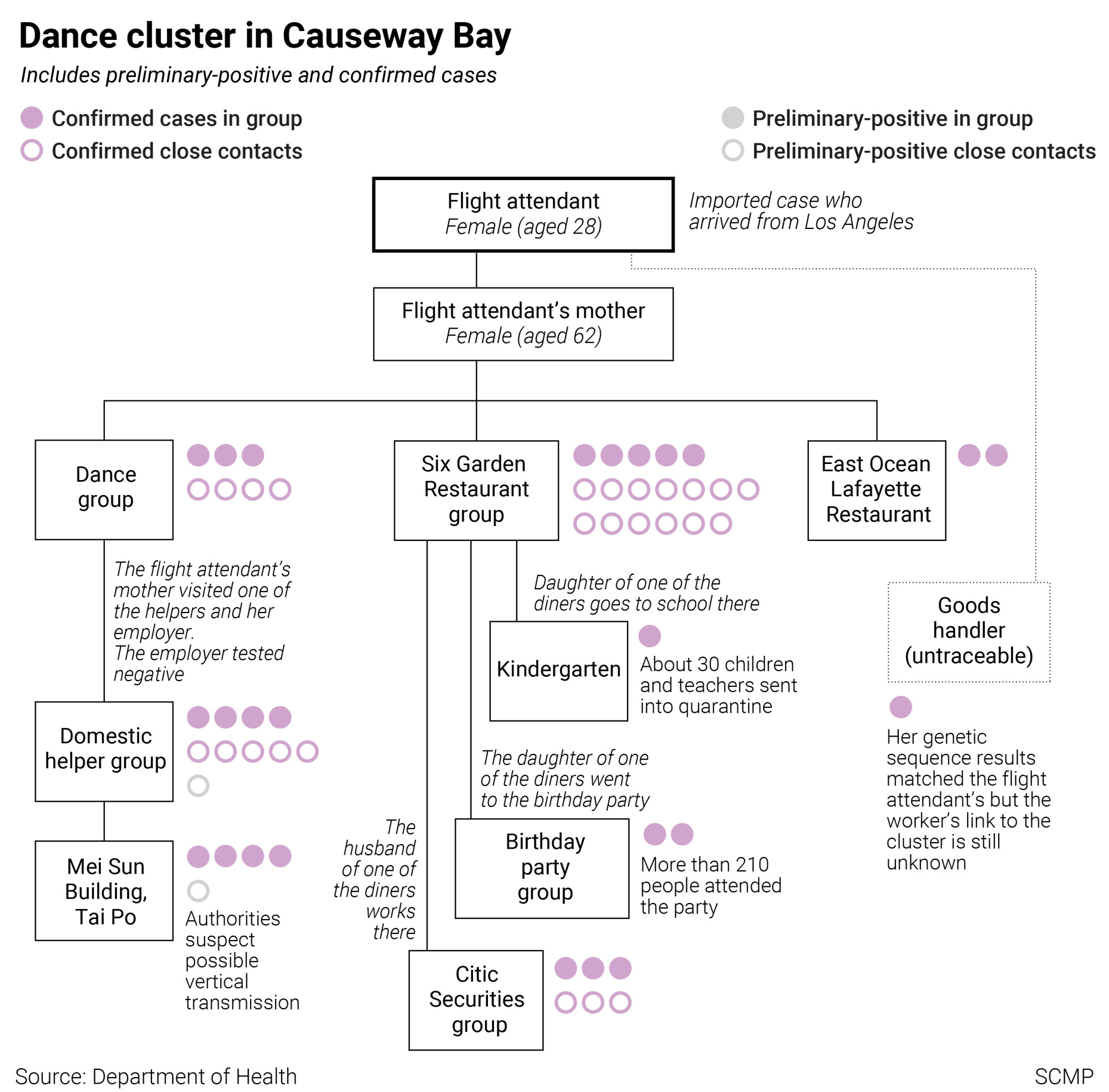
Coronavirus: how Omicron is spreading in Hong Kong wave triggered by Cathay Pacific aircrew and a relative linked to 32 other confirmed infections
- Biggest spreader is a flight attendant’s mother who directly infected eight people to cause fifth-generation transmission in less than a fortnight, Post study finds
- Nearly a third of Hongkongers infected in Omicron outbreak are aged 60 or above, raising concerns over older generation’s plight should cases surge
The analysis also revealed that as of Monday about a quarter of those infected with the new coronavirus variant were elderly, of whom 35.7 per cent were unvaccinated, raising concerns over the plight of the older generation should cases surge.
But epidemiological experts said even those who had taken the jabs were prone to catching the new variant given that antibody levels could drop significantly several months after the first two doses, as they urged residents to get a booster shot as soon as they became eligible.
‘High risk’ of Omicron infection in 5 Hong Kong districts in coming week: study
Hong Kong’s fifth wave of infections started to emerge at the end of December, spreading from two Omicron-carrying aircrew members, one of whom was confirmed to have broken Covid-19 rules. Exempted from hotel quarantine, he was found to have flouted isolation regulations originally designed for cargo pilots by leaving his home for non-essential reasons.
The infections of the two Cathay Pacific flight attendants, both vaccinated and returning from the United States, have already spread to a total of 46 residents across two clusters, comprising 32 women and 14 men, aged three to 88, and tied to a Kowloon Tong restaurant and Causeway Bay dance group.

At 36.1 per cent, unvaccinated patients account for a bigger proportion of the dance cluster than the restaurant one. The source of the outbreak among the dancers, who met in Victoria Park, was traced to the mother of a female flight attendant.
The other cluster was triggered by a male flight attendant who ate with his family in Moon Palace restaurant in the Festival Walk shopping centre during his isolation period. Of those infected in that group, 25 per cent were unvaccinated.
Among the vaccinated patients from the two clusters, 30.6 per cent of them received the Sinovac shot, and 63.9 per cent were administered with the BioNTech version. The rest were vaccinated outside Hong Kong with jabs produced by Sinopharm or AstraZeneca.

Officials have also repeatedly emphasised the importance of vaccination by pointing to the flight attendant’s mother not getting inoculated and therefore carrying a high viral load that is more likely to lead to widespread contagion.
The 62-year-old directly infected at least eight people over two days, including three dance group friends and two patrons sitting at a nearby table in a Causeway Bay restaurant. A total of 32 confirmed cases across five groups are linked to the woman, including a chain of transmission reaching fifth-generation spread in 12 days.

In that chain, the variant slipped into the Citic Securities workforce on January 2 when a member of staff at the investment bank caught the virus from his dancer wife, who had socialised with the flight attendant’s mother on December 31.
Two staff and a 71-year-old woman who visited the company on January 3 were confirmed as infected. A family member of the 71-year-old was also confirmed as infected on Tuesday.
The dancer’s wife, her husband and one of his infected colleagues were unvaccinated.

In the restaurant cluster, a pharmacy owner was revealed on Tuesday to have caught the virus from an infected aircrew member who visited the store before dining at Moon Palace on December 27.
Three family members of the shop owner have now tested positive. All four were not vaccinated.
But the variant has still managed to break through a chain of vaccinated people.
Omicron: Hong Kong to suspend classes, fears grow over ‘high-risk’ Tuen Mun
In one example, an inoculated friend of the flight attendant’s mother exposed the coronavirus to her grandson, colleague and her daughter.
The daughter then brought the virus to a scandal-hit birthday party for a pro-Beijing politician in Wan Chai, held on January 3 and attended by 214 people including top officials and lawmakers.
In another group, a vaccinated domestic helper spread the virus to three church-goers, who infected their family members as well as people living in the same building within 10 days. The helper was found to have a higher viral load than the flight attendant’s mother.

Government pandemic adviser Professor David Hui Shu-cheong, of Chinese University, said the viral load in some vaccinated people was high because their antibody levels had declined over time, noting the helper was vaccinated with two BioNTech doses back in April and May last year.
He said the extent of transmission was also determined by external factors, such as how successful contact-tracing was in identifying close contacts and Omicron’s shorter incubation period, which speeds up the rate of community infections.
“The only conclusion is that unvaccinated people must carry a high viral load,” he said. “That’s why we must push people to get their third shot.”
Hong Kong leader vows legal action if Cathay exploited quarantine rules
Meanwhile, 26.4 per cent of the local cases in the fifth wave are aged 60 or above, with one of the patients older than 80. Only two-thirds of those are vaccinated. Some 22.6 per cent of fifth-wave patients are in their 40s.
Respiratory medicine expert Dr Leung Chi-chiu said most of the patients in this outbreak were middle-aged or older, which he attributed to dancing in public parks being a common activity for older generations and the increased likelihood of the elderly developing symptoms, making it easier to identify them as Covid-19 cases.
Asked whether the city was likely to register its first death relating to Omicron in the near future given a third of elderly people listed as cases were unvaccinated, Leung said age was not the only concern with the state of a patient’s health also a key factor.
Hui noted it was inevitable the death toll would increase in line with a rising number of cases, but added: “Fortunately the Omicron variant is milder than the Delta variant, the risk of developing serious illness is not that high.”
Faced with the threat of more cases, the city has ramped up its efforts to vaccinate its older residents.
Hong Kong to provide 150 more quarantine hotel rooms for arriving helpers
In a press conference on Tuesday, Chief Executive Carrie Lam Cheng Yuet-ngor announced that the number of government health care centres for the elderly offering vaccination would increase fivefold to 15, allowing an extra 2,000 jabs to be administered daily.
Lam added she expected the city’s overall inoculation rate to soon hit 90 per cent if the vaccination drive continued at its current pace.

